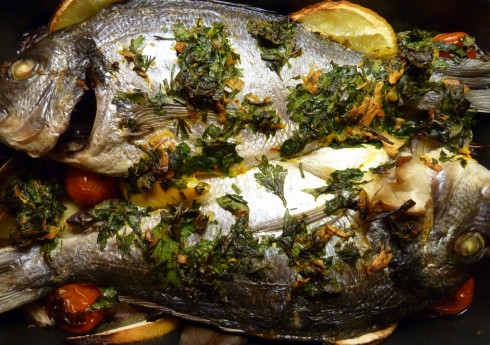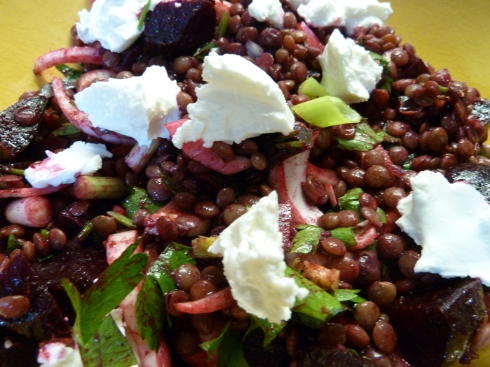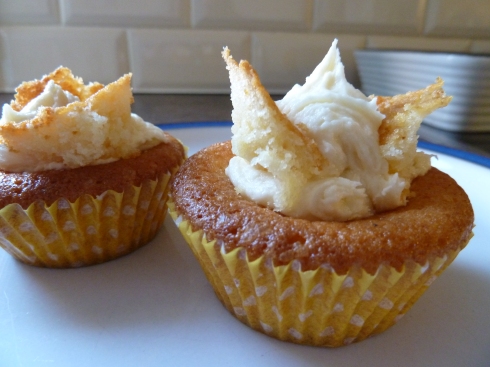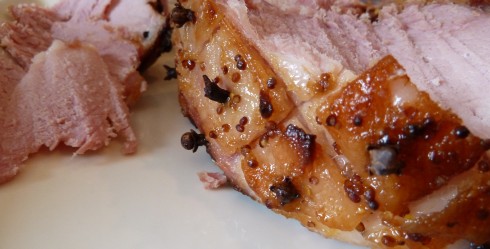You are currently browsing the monthly archive for April 2013.
In my head, this is always called Bella Lugosi, but that is just because I’m a dimwit. In the real world this, apparently, is the traditional Christmas-Eve meal that they eat in Spain. It is certainly one for the special occasion – first of all, because among its many ingredients is saffron, which always sets the alarm bells ringing, but also because in the UK at least, Sea Bream is not a cheap fish. I spent £9.30 on two fish at Soper’s, my wonderful local fishmongers.
On the plus-side, as well as being a hearty, tasty dish, it is also very easy to make. And apart from the par-boiling of the potato, you could call it a one-pot meal.
I have adapted this recipe from one which used to be on the BBC Good Food website, and Sophie Grigson and William Black’s Fish.
Ingredients
- 300g new potatoes
- 2 small red onions
- 2 sea bream
- 5 small tomatoes (I used sundream tomatoes)
- 1/2 lemon cut into sections
- 2 bay leaves
- 100ml white wine
- 4 garlic cloves
- 1 tsp Halen Môn sea salt
- a pinch of saffron
- a handful of flat-leaf parsley, chopped
- a good glug of olive oil
- 1 tbsp hot water
Par-boil the potatoes for 15 minutes or so. This can be done a day ahead.
Set the oven to 200C.
Slice the potatoes and onions and layer in an oven-proof dish. Put the sea bream on top, and find room in the dish for the lemon, bay-leaves and tomatoes.
Pour the white wine over the fish and vegetables.
Next, in a pestle and mortar, make a paste from the garlic, salt, parsley, saffron and olive oil. Loosen the paste with a spoonful of hot water.
Spread the paste over the fish.
Bake in the oven for 30 minutes.
SERVES 2.
Someone made this at Easter when we had a lovely family gathering, bring-your-own-dish, lunch. The best thing about this is that I’m the only one in the family to like beetroot, although I did put it out as a side-dish just to tease the kids. I should have got the recipe, because it was so earthy and delicious. But here’s my attempt to replicate it…
Ingredients
- 500g beetroot
- 150g green/le-Puy lentils
- 4 spring onions, sliced
- 1 handful of flat-leaf parsley, chopped
- 1 small bulb of fennel, sliced finely
- 4 spring onions, or 1/2 red onion
- zest and juice of 1/2 lemon
- a glug of olive oil
- a dash of balsamic vinegar
- 100g soft goats’ cheese (or you could try feta)
Set the oven to 200C.
Roast the beetroot for about 45 minutes, depending on the size of your beets. When the beetroot have cooled, peel and cube.
Boil the lentils for 25 minutes or so, until soft.
When the beetroot and lentils have cooled, add the spring onions, parsley, fennel, lemon, olive oil and balsamic vinegar.
Arrange the cheese over the salad.
You could add rocket, if you need additional greenery
SERVES 1 greedy vegetarian over a couple of days.
Not really cough-drops, just the slightly medicinal-sounding combination of honey and lemon. I’ve never made these before, and really did think they might turn out like Lemsip – but they were surprisingly delicious, if a little on the sweet side. I just loved the mellowness of the honey. I had originally planned to do a honey glaze, but the cakes sank a little so I gave them the butterfly treatment instead.
Ingredients
For the cakes
- 100g butter
- 75g sugar
- 2 tbsp runny honey
- 2 eggs
- zest and juice of 1 lemon
- 100g self-raising flour
For the honey buttercream frosting
- 80g butter
- 100g icing sugar
- 1 tbsp honey
The cakes
Set the oven to 180C.
Beat the butter and sugar together until light and fluffy. Add the eggs one at a time, beating continuously. Add the lemon and lemon zest. If the mixture starts to separate add a spoonful of the flour.
Sieve the rest of the flour and fold into the other ingredients.
Spoon the mixture into cake cases.
Bake at 180C for 20 minutes or so.
The frosting
Whisk all the ingredients together. Scoop out a hole in the centre of each cake – slice the cut-out into two ‘wings’. Fill the holes with frosting and pop the wings back on.
MAKES 12.
Easter feels like a long time ago, but since the children are still off school, I think this can just about make a claim to be an Easter ham, rather than just a ham. Everyone said this was delicious, and even I was tempted to have a little nibble, even though I don’t eat meat. I’m just hoping there’ll be some left portion off and freeze, because it is very useful for adding to chicken dishes.
There are lots of recipes for hams, including boiling in cola, or using ginger wine and marmalade in the glaze. I have kept things simple here, but it this is an easy, basic recipe that can be adapted depending on how creative you’re feeling.
Ingredients
Stage 1 – soaking the ham
- ham joint
- cold water
Stage 2 – boiling the ham
- 1 carrot, sliced
- 1 leek, trimmed and sliced
- 1 small onion, quartered
- 2 bay leaves
- 1tsp peppercorns
Stage 3 – glazing and roasting
- 1tsp dijon mustard
- 1tsp wholegrain mustard
- 2tbsp runny honey
- cloves, for studding
Stage 1
The first question is to soak or not to soak. Most recipes these days say not to bother. I thought the children would prefer the ham it if it were a little less salty, so I soaked it overnight in a pan of cold water.
Stage 2
Pour out the soaking water and top up with fresh, cold water. Add the carrot, leek, onion, bay leaves and pepper and simmer for about an hour and a half.
Stage 3
Set the oven to 200C.
Leave the ham to cool in its stock for half an hour or so. When it is cool enough to handle, use a sharp knife to cut the skin, and a little of the fat off the ham. Score the ham to make a diamond pattern.
Mix the honey and mustard together and drizzle and rub it into the ham.
Stud the cloves into the centre of each diamond.
Bake for 20-25 minutes. Great hot or cold.
I’d like to say that the kids decorated these, but unfortunately it is all my own work. I admit that my piping skills need a little bit of improvement. To be honest, I think these would be nicer without the little Easter eggs, but it is Easter Monday after all.
Ingredients
For the cakes
- 100g butter
- 100g sugar
- 2 eggs
- 100g self-raising flour
- 2 tsp coffee mixed with 1 tbsp hot water
For the icing
- 80g butter
- 160g icing sugar
- 2 tsp coffee mixed with 1 tbsp hot water
The cakes
Set the oven to 180C.
Beat the butter and sugar together until light and fluffy. Add the eggs one at a time, beating continuously. Add the coffee mixture.
Sieve the flour and fold into the other ingredients.
Spoon the mixture into cake cases.
Bake at 180C for 20 minutes or so.
The icing
When the cakes have cooled, beat the ingredients together until fluffy. Pipe the icing over the top. At other times of year a walnut half would probably be a more appropriate decoration. But use your imagination, it’s no big deal.
MAKES 12.





